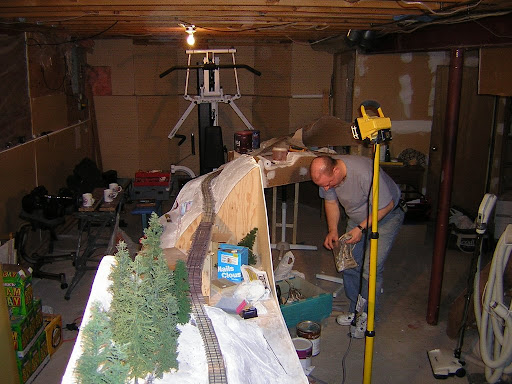Overall, the 2nd Ontario Narrow Gauge Show went well. While not being attended by thousands of rabid modellers, the 130+ visitors, vendors, and exhibitors seemed to enjoy themselves thoroughly.
The continuous loop micro-layout form of display was the overwhelmingly popular format, and will likely continue to be so for the foreseeable future. Despite the limitations of the style (primarily lack of operational possibilities, very tight curves, and short length of run), the benefits of quick setup and unattended running are attractive to a great many builders - especially the lone wolves.
On the other front, the 3-section "Cooper & Sawyer" On30 display layout of Pete Reisiger was present next to his Creative Works 3D stand. Pete has indicated that he's thinking of trying a FreeMOn30 style replacement as the C & S is due for retirement.
The Peterborough Model Railroaders had a deceptive point-to-point on a board of about 3'x5' dimension (possibly smaller). It appeared to be a continuous run at first glance, but offered some shunting and short runs in a nicely sceniced package.
Our FreeMOn30 setup consisted of the large river gorge, loop & wye, and tiny creek scenes as only 3 members with modules could attend. The lack of the harbour terminus made it a "pointless to loop" arrangement, and required a quick stop before a train could take the long plunge to the floor. Our 4th member brought excellent scratchbuilt ore cars, flats, and a caboose all equipped with Sergent couplers.
Thanks to the Digitrax Empire BuilderII system and a passing siding on the loop, we were able to keep two trains in operation at all times. One with the BLI C-16 and the other with a Bachmann Climax equipped with a Soundtraxx PnP decoder. Four UP5 panels were arrayed along the layout using clamps under the fascia to provide throttle plug-in points.
Operationally, the major problems evidenced were with the long rigid wheelbase of the C-16 over the pointwork, and the pickup wipers on the virginal Climax which kept breaking contact on sharp radii. However, the worst offense was the overall alignment of the tiny Whisky Creek module. Thanks to the intent to build the unit as light as possible, a bow developed along its short length that resulted in unacceptable track humps at each interface. These were sufficient to cause uncoupling of the engine from its cars. It may be possible to repair the module, but it might not be worth doing in terms of effort. Likely it will be relegated to a display/photo stand.
It's possible that the show will now alternate with the Great British Train Show in a biennial cycle, with the NG Show on the odd years. This will allow for more progress to be made, or entire new layouts to be built in the intervening timeframe to encourage display variety.

